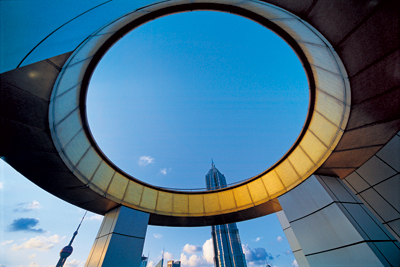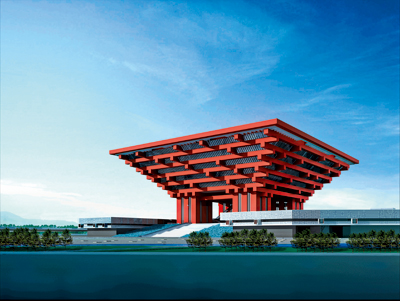The city is emerging from a major renewal campaign right on time for Expo 2010’s opening, Brent Hannon reports
Shanghai has opened 250km of subway line in the past five years, is extending the Maglev train that runs from the airport to a suburb of Pudong, is adding three runways to its gateway airport, and is building a mammoth cruise ship terminal that can berth four jumbo passenger liners at the same time. But even by these standards, the US$4 billion Expo 2010 project is exceptional.
Like magic, the rust-bucket industries that once collected on this prime stretch of urban waterfront beneath the Lupu Bridge have been erased. Gone are the giant Jiang Nan shipbuilding company and the grubby steel mill that until very recently spewed soot and cinder onto the city. Some 18,000 families have been relocated, and more than 250 other factories closed, to clear the 5.28sqkm piece of land that includes 8.3km of Huangpu riverfront. On that giant piece of land, more than 200 countries are now building pavilions, and organisers expect some 70 million visitors to squeak through the turnstiles between May 1 and October 31.

Most World Expos are not nearly as ambitious as this one. The three-month “Water Expo” in Zaragoza, Spain, attracted six million spectators in 2008, and the expo before that, in Aichi, Japan in 2005, ran for six months and saw 22 million visitors. But some expos do become forever famous. The New York Expo in 1939 earned star status when it displayed a new invention called television. At the Paris Expo in 1889, the legendary Eiffel Tower was unveiled, and the Crystal Palace was built for the first-ever World’s Fair, held in London in 1851. The ice-cream cone was invented at the St. Louis World’s Fair in 1904, which also inspired the celebrated song Meet Me in St. Louis. Elvis Presley starred in a movie about the Seattle World’s Fair in 1962, and the Space Needle was introduced then as well. Clearly, Shanghai wants to achieve something similar.
Expo 2010 has also spawned dozens of satellite projects and civic cleanup operations. As opening day approaches, the city is fussing like a tai tai in front of a mirror, smoothing out wrinkles and applying fresh makeup in strategic places. Hundreds of city buildings have been freshly painted, and sidewalks have been repaved, street signs replaced and elements of immorality expunged. If you wish to buy street CDs or “North Fake” jackets or “brand name” watches and bags, you should do it now because they will disappear from the local landscape as Expo approaches.
Another likely cleanup victim is Tong Ren Road in Jing An district, the neon-lit cluster of bars and nightclubs that was once Shanghai’s liveliest collection of late-night fun. It is true that Tong Ren Road got a bit out of hand, with flocks of girls chasing patrons up and down the street, and rip-offs galore going on inside the bars. The city has decided that it doesn’t need that kind of publicity, and by Expo, Tong Ren will almost certainly be gone.
But the most notable pre-Expo makeover is the Bund waterfront, which is currently a busy building site that will be finished just in time for Expo. A tunnel is being built beneath Zhongshan East Road – the busy six-lane road that separates the Bund buildings from the riverfront promenade – to ease car and truck traffic. With the road traffic much reduced, the Bund waterfront will become a broad, user-friendly park that will feature a new dock to serve the fast-growing fleet of sightseeing boats on the Huangpu River.
As for the Expo itself, it is likely to be spectacular. More than 200 countries and their corporate sponsors are seizing the chance to introduce themselves to China, and they are building some remarkable pavilions. The United Arab Emirates has created a graceful, wavy, rose-red structure that looks exactly like a sand dune, with a wall of windows at the steep edge. The Swiss chalet will have a ski lift, the Australian pavilion will look like Ayers Rock, and the Malaysia pavilion will display the graceful peaks of a traditional Malaysian dwelling.

The list goes on: Thailand’s will resemble a Thai Temple, Brazil’s will look like a bird’s nest (a tribute to the Olympic Stadium in Beijing) and France will present a “floating pavilion” surrounded by water like a Monet painting. Denmark will pry the Little Mermaid from her comfortable perch and fly her to Expo, where she will be surrounded by water from Copenhagen harbour, while Hongkong is creating a modernistic metallic structure with clear exteriors and a replica of a wetland park inside. The red inverted pyramid of the China pavilion will be the most visible, because at 60m, it towers high above all the rest. That is not by chance – all other countries have a height limit of just 20m.
So the pavilions will be dramatic, for sure, although the logistics do present a serious challenge. For example, the organisers do not plan to limit the number of spectators pouring through the gates. Anyone who has ever joined a “queue” in Mainland China knows that sounds like a recipe for disaster, especially when some 70 million people from the interior provinces are all struggling to see the same attractions. It is not everyone’s idea of a good time.
Such issues do not concern Shanghai’s hoteliers, who are very excited about Expo, and who are desperate for some good news in the current bleak market. As they like to point out, Expo 2010 will last for six months, compared with just two weeks for the Beijing Olympics. And it seems unlikely that China will shut down for Expo the way it did for the Olympics, when it stopped issuing visas to overseas travellers and instead held its own private party.
So, what will happen to the vast site on November 1 after the last visitor departs? Alas, most of the pavilions will be dismantled and the area will be turned over to developers. Three years ago, when Expo was a mere blueprint, the participating countries were told that 14 pavilions would be preserved, but they were not told which ones they would be. In the resulting limbo, some countries built permanent pavilions while the others built temporary ones.
The China Pavilion will stay, and so will the large, dome-shaped Performance Center. Some of the remaining pavilions have been sold and will be rebuilt in provincial capitals around China, and some will remain, although it is still not clear which ones. Meanwhile, all the rest, remarkable and expensive though they may be, are destined for the dustbin of architectural history.
Which is a shame, because Shanghai needs more parks and more public amusements, especially in its downtown core. In a world of cookie-cutter theme parks, what could be more fun than a spacious public park filled with pavilions from around the world? But currently, the site is slated for redevelopment, which in Shanghai always means residential blocks, malls, offices and other mundane money-making structures. Yet nothing has been decided for sure, and in any case, that may be looking too far into the future. Shanghai has a World Expo to hold first.
For more information, visit www.expo2010china.com








